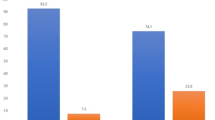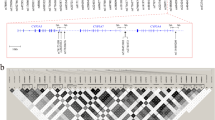Abstract
Few studies have investigated the correlation between pharmacogenomics and tacrolimus pharmacokinetics in patients with nephrotic syndrome (NS). This study evaluated the influences of genetic polymorphisms of metabolic enzymes, transporters, and podocyte-associated proteins on tacrolimus concentration in Chinese pediatric patients with refractory NS. A total of 167 pediatric patients with refractory NS were included from July 2013 to December 2017. Age of onset was restricted to <14 years of age. Dose-adjusted tacrolimus trough concentration (C0/D) on the third month was calculated, and 20 single-nucleotide polymorphisms in sixteen genes were genotyped. Age was correlated with tacrolimus C0/D (p = 0.006, r = 0.213). Tacrolimus C0/D was higher in CYP3A5 nonexpressers than in CYP3A5 expressers (p = 0.003). ACTN4 rs62121818, MYH9 rs2239781, CYP3A5*3, and age explained 20.5% interindividual variability of tacrolimus concentration in the total cohort. In CYP3A5 nonexpressers, ACTN4 rs62121818 and MYH9 rs2239781 together explained 14.6% variation of tacrolimus C0/D. MYH9 rs2239781, LAMB2 rs62119873 and age together explained 22.3% variability of tacrolimus level in CYP3A5 expressers. CYP3A5*3 was still an important factor affecting tacrolimus concentration in patients with NS. Podocyte-associated gene polymorphisms, especially ACTN4 rs62121818 and MYH9 rs2239781, were the other most important biomarkers for tacrolimus whole blood levels. Genotyping of CYP3A5, ACTN4, and MYH9 polymorphisms may be helpful for better guiding tacrolimus dosing in pediatric patients with refractory NS.
This is a preview of subscription content, access via your institution
Access options
Subscribe to this journal
Receive 6 print issues and online access
$259.00 per year
only $43.17 per issue
Buy this article
- Purchase on Springer Link
- Instant access to full article PDF
Prices may be subject to local taxes which are calculated during checkout





Similar content being viewed by others
References
Eddy AA, Symons JM. Nephrotic syndrome in childhood. Lancet. 2003;362:629–39.
Beck L, Bomback AS, Choi MJ, Holzman LB, Langford C, Mariani LH, et al. KDOQI US commentary on the 2012 KDIGO clinical practice guideline for glomerulonephritis. Am J Kidney Dis. 2013;62:403–41.
Nishi S, Ubara Y, Utsunomiya Y, Okada K, Obata Y, Kai H, et al. Evidence-based clinical practice guidelines for nephrotic syndrome 2014. Clin Exp Nephrol. 2016;20:342–70.
Wallemacq PE, Verbeeck RK. Comparative clinical pharmacokinetics of tacrolimus in paediatric and adult patients. Clin Pharmacokinet. 2001;40:283–95.
Evans WE, McLeod HL. Pharmacogenomics-drug disposition, drug targets, and side effects. N Engl J Med. 2003;348:538–49.
Rojas L, Neumann I, Herrero MJ, Boso V, Reig J, Poveda JL, et al. Effect of CYP3A5*3 on kidney transplant recipients treated with tacrolimus: a systematic review and meta-analysis of observational studies. Pharmacogenomics J. 2015;15:38–48.
Khaled SK, Palmer JM, Herzog J, Stiller T, Tsai NC, Senitzer D, et al. Influence of absorption, distribution, metabolism, and excretion genomic variants on tacrolimus/sirolimus blood levels and graft-versus-host disease after allogeneic hematopoietic cell transplantation. Biol Blood Marrow Transplant. 2016;22:268–76.
Birdwell KA, Decker B, Barbarino JM, Peterson JF, Stein CM, Sadee W, et al. Clinical Pharmacogenetics Implementation Consortium (CPIC) Guidelines for CYP3A5 Genotype and Tacrolimus Dosing. Clin Pharm Ther. 2015;98:19–24.
Birdwell KA, Chung CP. The potential of pharmacogenomics to advance kidney disease treatment. Clin J Am Soc Nephrol. 2017;12:1035–7.
Hao GX, Huang X, Zhang DF, Zheng Y, Shi HY, Li Y, et al. Population pharmacokinetics of tacrolimus in children with nephrotic syndrome. Br J Clin Pharm. 2018;84:1748–56.
Li JL, Liu S, Fu Q, Zhang Y, Wang XD, Liu XM, et al. Interactive effects of CYP3A4, CYP3A5, MDR1 and NR1I2 polymorphisms on tracrolimus trough concentrations in early postrenal transplant recipients. Pharmacogenomics. 2015;16:1355–65.
Faul C, Asanuma K, Yanagida-Asanuma E, Kim K, Mundel P. Actin up: regulation of podocyte structure and function by components of the actin cytoskeleton. Trends Cell Biol. 2007;17:428–37.
Tryggvason K, Pikkarainen T, Patrakka J. Nck links nephrin to actin in kidney podocytes. Cell. 2006;125:221–4.
Warejko JK, Tan W, Daga A, Schapiro D, Lawson JA, Shril S, et al. Whole exome sequencing of patients with steroid-resistant nephrotic syndrome. Clin J Am Soc Nephrol. 2018;13:53–62.
Cheng W, Zhou X, Zhu L, Shi S, Lv J, Liu L, et al. Polymorphisms in the nonmuscle myosin heavy chain 9 gene (MYH9) are associated with the progression of IgA nephropathy in Chinese. Nephrol Dial Transplant. 2011;26:2544–9.
Dandapani SV, Sugimoto H, Matthews BD, Kolb RJ, Sinha S, Gerszten RE, et al. Alpha-actinin-4 is required for normal podocyte adhesion. J Biol Chem. 2007;282:467–77.
Feng D, DuMontier C, Pollak MR. The role of alpha-actinin-4 in human kidney disease. Cell Biosci. 2015;5:44.
Faul C, Donnelly M, Merscher-Gomez S, Chang YH, Franz S, Delfgaauw J, et al. The actin cytoskeleton of kidney podocytes is a direct target of the antiproteinuric effect of cyclosporine A. Nat Med. 2008;14:931–8.
Zhang Q, Shi SF, Zhu L, Lv JC, Liu LJ, Chen YQ, et al. Tacrolimus improves the proteinuria remission in patients with refractory IgA nephropathy. Am J Nephrol. 2012;35:312–20.
Li JL, Wang XD, Chen SY, Liu LS, Fu Q, Chen X, et al. Effects of diltiazem on pharmacokinetics of tacrolimus in relation to CYP3A5 genotype status in renal recipients: from retrospective to prospective. Pharmacogenomics J. 2011;11:300–6.
Zhang Y, Li JL, Fu Q, Wang XD, Liu LS, Wang CX, et al. Associations of ABCB1, NFKB1, CYP3A, and NR1I2 polymorphisms with cyclosporine trough concentrations in Chinese renal transplant recipients. Acta Pharm Sin. 2013;34:555–60.
Sole X, Guino E, Valls J, Iniesta R, Moreno V. SNPStats: a web tool for the analysis of association studies. Bioinformatics. 2006;22:1928–9.
Wallemacq PE, Furlan V, Moller A, Schafer A, Stadler P, Firdaous I, et al. Pharmacokinetics of tacrolimus (FK506) in paediatric liver transplant recipients. Eur J Drug Metab Pharmacokinet. 1998;23:367–70.
Sun JY, Xu ZJ, Sun F, Guo HL, Ding XS, Chen F, et al. Individualized tacrolimus therapy for pediatric nephrotic syndrome: considerations for ontogeny and pharmacogenetics of CYP3A. Curr Pharm Des. 2018;24:2765–73.
Terrazzino S, Quaglia M, Stratta P, Canonico PL, Genazzani AA. The effect of CYP3A5 6986A>G and ABCB1 3435C>T on tacrolimus dose-adjusted trough levels and acute rejection rates in renal transplant patients: a systematic review and meta-analysis. Pharmacogenet Genomics. 2012;22:642–5.
Kamdem LK, Streit F, Zanger UM, Brockmoller J, Oellerich M, Armstrong VW, et al. Contribution of CYP3A5 to the in vitro hepatic clearance of tacrolimus. Clin Chem. 2005;51:1374–81.
Wang D, Johnson AD, Papp AC, Kroetz DL, Sadee W. Multidrug resistance polypeptide 1 (MDR1, ABCB1) variant 3435C>T affects mRNA stability. Pharmacogenet Genomics. 2005;15:693–704.
Brambila-Tapia AJ. MDR1 (ABCB1) polymorphisms: functional effects and clinical implications. Rev Investig Clin. 2013;65:445–54.
Noone DG, Iijima K, Parekh R. Idiopathic nephrotic syndrome in children. Lancet. 2018;392:61–74.
Liao R, Liu Q, Zheng Z, Fan J, Peng W, Kong Q, et al. Tacrolimus protects podocytes from injury in lupus nephritis partly by stabilizing the cytoskeleton and inhibiting podocyte apoptosis. PLoS ONE. 2015;10:e0132724.
Shen X, Jiang H, Ying M, Xie Z, Li X, Wang H, et al. Calcineurin inhibitors cyclosporin A and tacrolimus protect against podocyte injury induced by puromycin aminonucleoside in rodent models. Sci Rep. 2016;6:32087.
Critchley DR. Focal adhesions—the cytoskeletal connection. Curr Opin Cell Biol. 2000;12:133–9.
Zhao X, Hsu KS, Lim JH, Bruggeman LA, Kao HY. alpha-Actinin 4 potentiates nuclear factor kappa-light-chain-enhancer of activated B-cell (NF-kappaB) activity in podocytes independent of its cytoplasmic actin binding function. J Biol Chem. 2015;290:338–49.
Khurana S, Chakraborty S, Zhao X, Liu Y, Guan D, Lam M, et al. Identification of a novel LXXLL motif in alpha-actinin 4-spliced isoform that is critical for its interaction with estrogen receptor alpha and co-activators. J Biol Chem. 2012;287:35418–29.
Wakamatsu A, Fukusumi Y, Hasegawa E, Tomita M, Watanabe T, Narita I, et al. Role of calcineurin (CN) in kidney glomerular podocyte: CN inhibitor ameliorated proteinuria by inhibiting the redistribution of CN at the slit diaphragm. Physiol Rep. 2016;4:e12679.
Zangar RC, Bollinger N, Verma S, Karin NJ, Lu Y. The nuclear factor-kappa B pathway regulates cytochrome P450 3A4 protein stability. Mol Pharm. 2008;73:1652–8.
Gu X, Ke S, Liu D, Sheng T, Thomas PE, Rabson AB, et al. Role of NF-kappaB in regulation of PXR-mediated gene expression: a mechanism for the suppression of cytochrome P-450 3A4 by proinflammatory agents. J Biol Chem. 2006;281:17882–9.
Kim SJ, Lee S, Park HJ, Kang TH, Sagong B, Baek JI, et al. Genetic association of MYH genes with hereditary hearing loss in Korea. Gene. 2016;591:177–82.
Franceschini N, Voruganti VS, Haack K, Almasy L, Laston S, Goring HH, et al. The association of the MYH9 gene and kidney outcomes in American Indians: the Strong Heart Family Study. Hum Genet. 2010;127:295–301.
Lin MH, Miller JB, Kikkawa Y, Suleiman HY, Tryggvason K, Hodges BL, et al. Laminin-521 protein therapy for glomerular basement membrane and podocyte abnormalities in a model of Pierson syndrome. J Am Soc Nephrol. 2018;29:1426–36.
Funk SD, Bayer RH, Malone AF, McKee KK, Yurchenco PD, Miner JH. Pathogenicity of a human laminin beta2 mutation revealed in models of Alport syndrome. J Am Soc Nephrol. 2018;29:949–60.
Rood IM, Deegens JKJ, Lugtenberg D, Bongers E, Wetzels JFM. Nephrotic syndrome with mutations in NPHS2: the role of R229Q and implications for genetic counseling. Am J Kidney Dis. 2019;73:400–3.
Acknowledgements
This research was supported by grants from the National Natural Science Foundation of China (grant no. 81603203), the National Key Research and Development Program (grant no. 2017YFC0909303), the National Key Research and Development Program (grant no. 2016YFC0905001), Health Commission of Guangdong Province (grant no. 2016–568), Guangzhou Women and Children’s Medical Center/Guangzhou Institute of Pediatrics (grant no. YIP-2018–020). We thank the physicians (Fazhan Zhong, Huiying Deng, Fu Zhong, Ye Chen, Huabin Yang, and Zichuan Xu) and nurses (Hui Deng, Yuru Liao) from the division of nephrology for their contribution to patients’ recruitment and sample collection. Thank Caijiao Guo for her concentration determining assistance from the clinical laboratory. Thanks for the help of Fangling Zeng, Bing Zhu, and Yinghua Li from the central lab and Xiaojun Cao and Xu Lin from the department of science and education. Yanling He, Yingjie Li, and Min Huang had full access to all of the data in the study and take responsibility for the integrity of the data and the accuracy of the data analysis.
Author information
Authors and Affiliations
Corresponding authors
Ethics declarations
Conflict of interest
The authors declare that they have no conflict of interest.
Ethics statements
The study was performed according to the Declaration of Helsinki and guidelines on good clinical practice, and ethical approval was obtained from the ethics committee of Guangzhou Women and Children’s Medical Center (no. 201509). Written informed consent was obtained from all patients or their guardians before participation. This study was a part of a large clinical trial (NCT02602873), aiming to achieve individualized administration of tacrolimus in patients with pediatric NS.
Additional information
Publisher’s note Springer Nature remains neutral with regard to jurisdictional claims in published maps and institutional affiliations.
Supplementary information
Rights and permissions
About this article
Cite this article
Mo, X., Li, J., Liu, Y. et al. Kidney podocyte-associated gene polymorphisms affect tacrolimus concentration in pediatric patients with refractory nephrotic syndrome. Pharmacogenomics J 20, 543–552 (2020). https://doi.org/10.1038/s41397-019-0141-x
Received:
Revised:
Accepted:
Published:
Issue Date:
DOI: https://doi.org/10.1038/s41397-019-0141-x



